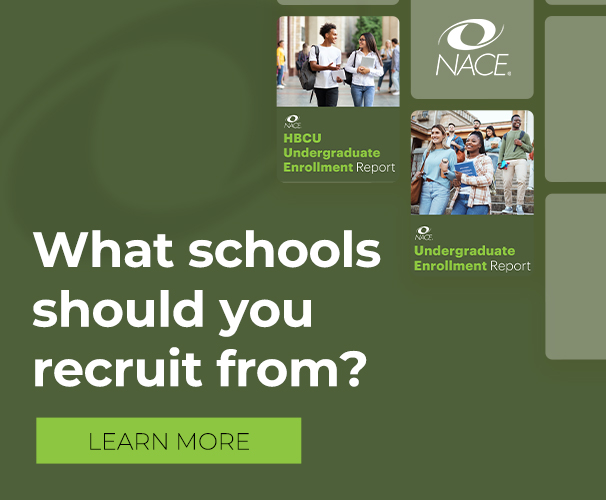Spotlight for Career Services Professionals
Spotlight for Recruiting Professionals
Not only are Historically Black Colleges and Universities (HBCUs) a source of accomplishment and pride for the Black community and higher education, they are a key source of high-quality, diverse talent for employers.
(The successes, issues, and solutions HBCUs achieve and encounter will be discussed during NACE’s HBCU Summit: Bridging College to Employment, which will be held virtually in partnership with INROADS on February 18 at 11 a.m. ET. Event and registration information is available on NACEWeb.org.)
When asked about challenges HBCUs face in attracting employers to recruit their students, Nicole Wormley, senior director, diversity attraction and university recruitment at Danaher Corporation, stated that, in her experience, it is less about challenges that HBCUs face and more about challenges that employers face to attract and convert HBCU talent.
“The talent is there,” Wormley says. “However, I have seen unrealistic expectations from employers become prohibitive.”
There is also the perception that a small number of HBCUs are targeted more than others. Wormley associated it with “tiering of school partnerships,” a recruiting methodology that she discontinued using years ago.
“I have eliminated the idea of tiering schools and that nomenclature from my company’s vocabulary because it perpetuates what could be perceived as classes and levels, and that one is better than another,” she explains.
“It creates division within a community that does not need it.”
Instead, she says, Danaher’s approach in recent years has been to cast a larger net, either across multiple HBCUs or with an organization that is comprised of many HBCUs.
“We are positioned well to advance our partnerships with HBCUs, and support and engage with HBCU students, while meeting the needs of the business,” Wormley adds.
That broader approach to recruiting at HBCUs could be imperative, as Harold Bell, director of career planning and development at Spelman College, says that visibility remains a major hurdle for these schools to clear.
“Many employers don’t know who the HBCUs are,” Bell says.
“Twenty-five percent of all African-American STEM majors graduate from HBCUs. If you are only focusing on two or three, it’s no wonder you can’t identify the talent. There are more than 100 HBCUs throughout the country. Employers first need to know that they are there, but then there’s the issue of organizations determining what majors and academic programs an HBCU offers to see if the school’s programs are congruent with the organization’s needs. We need to be visible and promote our majors so it is clear to recruiters how our students align with their needs.”
One key element to successful recruiting is authentic branding. Bell stresses that the branding that resonates with students at HBCUs is different from campus to campus.
“I am at an HBCU that exclusively has liberal arts majors, but no business majors,” he notes.
“So approaching my students must look and feel different than engaging students who are enrolled in a school of business. The same holds true for our faculty. The majority of them will represent the academy, and not have industry backgrounds.”
Bell’s students are also looking to make personal relationships with recruiters during the process.
“What resonates with our students,” he says, “is a more personable approach versus what I call the ‘Hollywood info session,’ during which an employer brings out all the bells and whistles. Our students are looking for authenticity and honesty, and they want to build personal relationships and trust during the recruiting process.”
This may mean a recruiter speaking with a small group of students, perhaps over coffee.
“This is a more human approach as opposed to a more transactional one,” Bell explains.
“Our students prefer the former. The gold standard to me is when, from a student’s perspective, an organization is no longer just brick and mortar and reputation, but it now has a recruiter’s name attached to it, and the student has a personal connection there. When a student asks for a recruiter by name, that’s when an organization has reached a higher level in terms of its marketing.”
Ingrid Giordano, director of university relations, campus diversity and marketing, global talent acquisition and people insights at Citi, agrees that establishing personal connections is effective.
“Understanding and celebrating the HBCU experience is important when thinking about marketing and branding,” Giordano says.
“Students at HBCUs value mentorship and consistency, and hearing from an organization’s leadership, potential managers, and alumni or previous interns. This will help them see themselves at an organization.”
Students expect that the organizations that recruit at HBCUs hold similar values as those held by the institution they are attending.
“Students expect that organizations are committed to diversity, equity, and inclusion, while providing students with a career with opportunities for learning and growth,” Giordano says.
“Employers should be authentic with their approach, demonstrating real initiatives that their organization is committing to both internally and externally. It is important for organizations to highlight how their company is taking action and that their commitment to diversity, equity, and inclusion is genuine.”
Nicole Wormley, Harold Bell, and Ingrid Giordano will be panelists during NACE’s HBCU Summit, which will be held virtually in partnership with INROADS on February 18 at 11 a.m. Event and registration information is available on NACEWeb.






